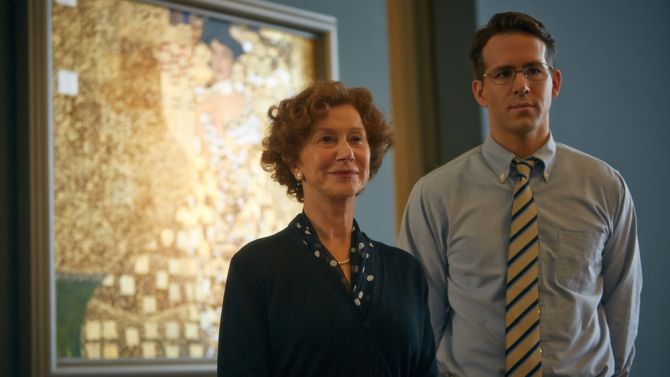“Woman in Gold” Depicts Harrowing History of Stolen Art

A highly affecting film, “Woman in Gold” reveals both the pain and joy inherent in reclaiming family heirlooms stolen during World War II. It’s a film that explores the inner battle of remembering a repressed past. And it’s one of those films that leaves you feeling sad, with its plot hinging on the tension created through the main character’s emotional flashbacks to the beginning of the Nazi occupation of Vienna. But the film ends (perhaps somewhat predictably) on a triumphant note.
The film depicts the legal battle over a Klimt portrait that that was stolen from the main character’s family in the midst of Nazi raids and eventually displayed in Vienna at the Belvedere Palace. In the forefront of the battle stand two Austrian Americans living in Los Angeles, an elderly Maria Altmann (played by Helen Mirren) paired with the generation-younger lawyer Randol Shoenberg (played by Ryan Reynolds). “Woman in Gold” is based on the true story of an actual battle between Altmann and the Austrian government, which took six years. The film itself is a brisk 109 minutes.
Following the death of her sister, Maria discovers decades-old letters that provide a basis to reclaim the famous Klimt portrait of her aunt. As she reads, she is flooded with memories of her childhood life and home in Vienna, all destroyed by Nazis. She asks a family friend and lawyer, Shoenberg, to explore the case, and the two find themselves struggling with difficult memories when they make a trip to Vienna. As if that weren’t enough, the two find themselves faced with a grueling legal battle as they fight for the precious portrait.
Reynolds’ character is in it for the money at first, but he eventually quits his newly acquired position at a law firm, throwing himself into the case. Although at first the pair leave Vienna empty-handed, Shoenberg finds a loophole in American law after many sleepless nights and an overwhelmingly large amount of photocopying. His pregnant wife, at first upset at their financial instability, eventually becomes supportive, and Shoenberg pursues suing the Austrian government through the Supreme Court. Through the process, he gains a greater sense of connection to his family’s history, learning more about his grandfather, who was a famous composer.
For Mirren’s character, the at-first unwanted return to Vienna is a difficult one, sparking flashbacks interspersed throughout the film — at first of happy memories with her family, but then of dark memories of the Nazi occupation. Her idyllic memories of childhood, then those of her festive marriage, quickly are replaced with scenes of the Viennese people welcoming the Nazis as she and her family run through the streets, frightened. Eventually, we see Maria barely evading police to flee the country, leaving her mother and dying father behind. These flashbacks give the film a gripping edge and pack an emotional punch that the film otherwise lacks. We learn that Maria is so scared of being overwhelmed by her own memories that she is reluctant to seek justice in the present. Helen Mirren plays this complicated character well.
Through the film, we see the different ways in which two generations remember the past. While Shoenberg’s generation has no immediate memory of these horrible events, for Maria they seem almost as real as if they were happening in the present.
In an especially thought-provoking scene, Maria’s reaction to finally viewing the painting in its new home at the museum is juxtaposed with the reaction of a tour group viewing the painting. This is the first time Maria has seen the painting since her childhood, when she saw it in her home every day. For the tourists, though, it’s just another painting in a museum.
The film’s title, “Woman in Gold,” alludes to the name the Klimt portrait was given in recognition of the years it lived through the war, enduring namelessness and erasure, representing a Jewish generation forever stripped of their Austrian identity.
Though the film is undoubtedly intended as a mainstream form of entertainment, it also has a deeper significance. We are approaching a world in which fewer and fewer people remember the Holocaust, and artistic representation, though deeply troubling and difficult to watch, are more necessary than ever.
In the end, the film becomes a tribute to the thousands of pieces of art stolen during this time period that have not yet been returned. It’s a film that reminds us why remembering is so essential. “Woman in Gold” keeps this important part of history alive, for now.





Comments ()